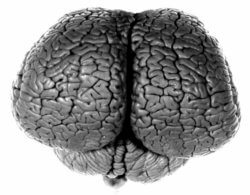Did you know that in terms of brain size and complexity, beluga whales are among the most sophisticated cetaceans?
These big beautiful brains underlie their exquisite intelligence, complex communication abilities, and highly curious nature.
 Beluga brains are indeed large. They weigh about 4.5 pounds (compared to the 2.75-pound human brain) and are more than twice the size you would expect for a mammal of their body weight. That means that like humans, they have a lot of brain power left over after you account for body maintenance. And that means a lot of brain tissue devoted to all the “heady” capacities like problem solving, emotions and communication.
Beluga brains are indeed large. They weigh about 4.5 pounds (compared to the 2.75-pound human brain) and are more than twice the size you would expect for a mammal of their body weight. That means that like humans, they have a lot of brain power left over after you account for body maintenance. And that means a lot of brain tissue devoted to all the “heady” capacities like problem solving, emotions and communication.
Beluga brains have several features that we know are related to complex intelligence in all mammals. Their neocortex – the part of the brain involved in analytical thinking, self-awareness, reasoning, perception and communication – has even more folds (known as convolutions) than the human brain, meaning that the surface area is greater.
Belugas may have even more processing elements in their neocortex than we do.This expansive elaboration of the neocortex suggests that belugas may have even more processing elements in their neocortex than we do. We’ve only just begun to understand what that means in terms of the sophisticated ways they may be processing information compared to how humans do this.
One way we know dolphins and whales process information differently from humans is that the part of their neocortex that first processes sound is right next to (adjacent to) the part of their neocortex that first processes vision. This is very different from the way human brains are organized: our sound and visual inputs have to go through a lot of brain “territory” before they come together. Scientists think the cortical adjacency, as it is called, in dolphin and whale brains may facilitate echolocation, in which sound and visual imagery are interchangeable.
All this brain power makes belugas naturally curious about their environment and unfit for the sterile unchanging conditions of a concrete tank. And those big brains allow belugas to have learned cultural traditions which they pass on from one generation to the next. That means they keep a lot of knowledge stored in their memories. Just like us, they need to explore, probe, play with, learn about, and be challenged by both their living and physical environment.
And that is what we will be providing for our sanctuary residents: a chance to finally exercise those big beautiful beluga brains.